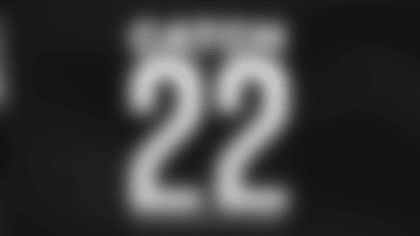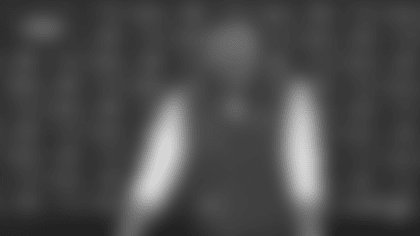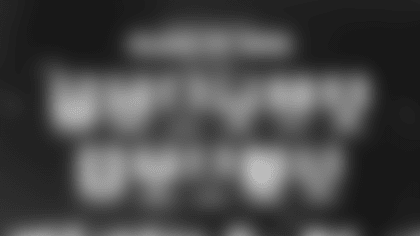BB: Well, I just wanted to really take this opportunity, first of all, to talk a little bit about our scouting staff, the job they've done this spring. As always, it's a very difficult job to manage the number of people in the system that we have to work through between all of the pro players from free agency, unrestricted free agency, restricted free agency, non-tendered players, potential trades, releases, things like that, that are constantly part of the system as well as the entire draft process with another record number of underclassmen this year – 130 or something – whatever it was. I would say just, in general, a continuing smaller sliver of opportunity to evaluate the players. I'm not saying we don't have an opportunity to do it, but it just gets progressively smaller on a number of areas throughout the process. It's, I think, really, a very thorough job by Nick [Caserio] and his staff. Nick does a tremendous job. He sees literally every player, all of the pro players, all of the college players as well as being in all of the staff meetings and being a part of all of the things we do from a coaching standpoint. It gives us a tremendous opportunity for him to connect with the coaches and understand the schematics and what's going on on the coaching side of it to try to integrate and correlate the players that we're evaluating on all of the different levels. I thought Dave Ziegler and his staff did a great job in free agency of, again, organizing all of that. They continued because of, again, the compression of the pro days, the college pro days, which has been going on but now this year it's really got compressed into pretty much a two week period, so we had to rely on those guys to supplement our pro day activity as well in the spring. Dave and his staff did a great job of helping us there with the college process. Monti [Ossenfort] and his staff, who have been working on the draft since the day after the 2018 Draft – well, actually before that – but let's call it the day after the 2018 Draft, again, compiled an enormous amount of information both from a football standpoint, character, medical and so forth on several thousand players, which gets whittled down to let's call it 100 or so in the final analysis, but you don't know what that number's going to be until you go through the entire process and it's a very lengthy and tedious one that Monti and his staff have, I think, done a great job on. Those guys certainly deserve a lot of the credit for the success that we've had, the players that we've been able to acquire and the enormous amount of work that they've produced, really, on a daily basis, but it adds up over weeks, months and years at a time. Being able to coordinate everything in there, which Nancy [Meier] and Brian Smith do a tremendous job of, just the volume that we have to deal with and their ability to put it into places where you can actually work through it in a meaningful way is an important part of the process, as well. That being said, this is a pre-draft press conference. I'll entertain anything relative to the 2019 Draft. I'd just say as a prelude to that, obviously, many of our 2018 draft choices had partial seasons or minimal in some cases. We're excited to see how those guys will do this year, obviously. It's a hardworking group. Those guys are here on a very consistent basis and hopefully we'll be able to get a much longer look at the 2018 draft class than we were able to get last year. Moving ahead to 2019, we have a lot of draft picks as we sit here today. I don't know that that necessarily means that they will or won't be there on draft weekend. We'll see how all of that goes. Just evaluate situations as they come up and try to make the best decisions we can for the football team. There's no set goal in mind as to how many picks to have or what to do with them. We just want to try to make good decisions at every opportunity we can to improve our team in whatever way is possible and that includes everything. It's all part of the team-building process and we'll see how all of that plays out. We know from a draft standpoint we're in the middle of our 30 draft visits this week, so we'll finish that up this week and into next week and then kind of finish up our final preparations with pulling it all together between the film evaluations, character evaluations, medical evaluations and trying to really get as good of a predictor as possible as to how the player will fit in and perform on our team, in our system, in New England regardless of what the league value is for the player. It's really what the player can do for us is what the final evaluation goal is that we're trying to achieve. That's kind of what we're working on now.
Q: How important is it to know some of the needs and desires of the teams immediately around you in the draft order?
BB: Yeah, we track that. We track it the best we can. I think there's a lot of misinformation that's out there now. There's sometimes other accurate information that you can obtain through one source or another. I think sometimes it's relevant. A lot of times it's not the team right in front of you; it's a team somewhere else. A team that could be, depending on what round you're in, at a location behind you, that may be looking at a certain position or a certain player that could affect your draft strategy, as well. The team in front of you might not have any need for or you know they wouldn't even want a type of player, maybe players that you're considering but that doesn't really mean anything because anybody could move up into that spot and take that player. It's all relevant. I know, you're right – in the first round, I mean, we're not going from [No.] 30 to eight, 32 to eight, whatever it is. That's not realistic. There could be a team at, whatever – 40, that's really more of a problem for us than the team at 31. Each round is different. Each situation is different. We usually have a decent amount of time between our picks to identify, "OK, here are the players that we're considering. Here are the teams that are around us." If one of those teams is actively trying to trade out then that means somebody is going to trade in and who could they be coming up for, how would that affect us, do we want to get ahead of that team, do we care?
Q: The trade to move up for Rob Gronkowski back in the 2010 draft is one that comes to mind as you moved up two spots and got ahead of Baltimore who was perhaps looking to draft a tight end, as well. Is that an example of an instance where you have to be conscious of who's around you at those points in the draft?
BB: Yeah, again, yeah, there's a lot of those – Matt Light was another example of that. Eugene Wilson. Look, there's multiple examples of it and moving back is obviously just the reverse of that if you feel like you can take the same player at a lower point in the draft and acquire another asset somewhere, there's merit to doing that. You don't want to lose the player that you want but maybe that's a player that or maybe there's multiple players there and in that particular circumstance that big of a differential. If you can gain an asset, gain value by doing that, then there's a strategy that makes that a consideration.
Q: How much does the trade chart that was popularized by Jimmy Johnson still play a part in the trades that go down in today's game? Do you find that most teams are working off of that same model?
BB: I would say that, in general, the trades over the last several years for the most part have been, let's call them within five to 10 percent, pretty equitable trades. So, for you to have a chart that's different than the other 31 charts isn't really that productive because now we're just arguing about which chart – "My chart says this. Your chart says that." I'd say officially or unofficially – well, it's unofficially – but I would say everybody probably uses about the same value chart. I'd say in our draft trade negotiations through the years, especially the last two or three years, there hasn't been a lot of, "My chart says this. Your chart says that." Now 10 or 15 years ago there was some of that. "Oh, here's what we think it should be." Well, the other team's in a different ballpark because they're looking at a different chart. I would say that when you look at the trades now, over the past few years, a majority of them fall within what we would say is a range of a fair trade. What the going rate would be is what the team gave up and what the team got is about what you would expect them to get, whether it's our trade or not. I'm just looking league wide. The first round is a little bit different because you're trading for a very specific player at that point. Not that you're not trading for a player in the second and third round – I'm not saying that – when a team moves up, they move up to take a certain player that they want. But not everybody's necessarily after that player, whereas in the first five, 10 picks, whatever it is, when you're trading there you're trading for a certain guy and when they trade out of it they know that they're trading away from that player. It might be one or two players but it's a much more defined situation.
Q: When a veteran is involved in these trades, do you think of the player in terms of pick value or how does that correlate?
BB: Yeah, again, sure. We have the different values that we place on future picks, current picks, the round values – and again, being the first pick in the round and the last pick in the round is not quite the same value – and so that can come into play on future picks. Veteran players, depending on their age, contract situation and level of play – again, we have comparables that we would look at on that, so a starter, rotational player, a backup, a player that has a certain amount of playtime or a player that has a certain amount of production, that there are comparables of those trades, whether it be player-for-player trades or player-for-pick trades. And again, certainly there are trades that fall outside of whatever the norm is, but we have norms that we look at it and that's the norm. And you can do better than that, or you probably feel like that's maybe about as good as you can do, assuming there isn't an unusual situation – whether it's a high demand for the player and it's below that – then you decide whether or not you want to accept maybe a little less than market value for the trade, but you still feel like the trade benefits your team, so you decide to do it. But, yeah, certainly the player-for-player or player-for-pick trades are different than the pick-for-pick trades, but we try to evaluate those, as well. And a lot of it, again, is placed on playtime, production and age and salary because salary is definitely a factor in what the trade value of a player is.
Q: The coaches are part of the scouting process, too, but you guys have have a lot of transition on the coaching staff this year. Have you noticed much effect on how you guys are scouting and setting your board and how the new coaches are settling into their roles?
BB: Probably a little less than normal – doing it, but still less activity with the coaching staff for the reasons you just articulated.
Q: Does losing your defensive coordinator at this point in the process change much in terms of how you scout or are going to be drafting on that side of the ball?
BB: Well, I mean, we're not talking about an unprecedented event here. Yeah, we've dealt with changes before. We'll continue to deal with them.
Q: Do you have any plans on how you're going to replace the defensive coordinator moving forward?
BB: You mean relative to the 2019 Draft?
Q: The draft and the season that comes after it, as well.
BB: Yeah, we'll just kind of stick to the draft for right now, Ben [Volin]. But I appreciate the question. I really appreciate you asking that.
Q: When you have players at a position that make an indelible mark among the most complete, best players at their positions in their careers and you have to draft players at those same positions, I'd imagine it would be unrealistic to try find the next guy who transcends and is an all-time great. How do you deal with that situation, specifically with Rob Gronkowski retiring? If you're looking at tight ends in the draft, how do you evaluate them fairly and totally?
BB: Yeah, well, I think for us, we have always looked to the future. So, each player is different. Each situation is different. Whatever a player was or wasn't in the past is in the past and our decisions are for the future. So, what player can we add to our roster in whatever way we add them, that is the best decision at that point in time for our football team and that's what we look at – not Mike Vrabel and Ted Washington and Deion Branch, whoever, Vince Wilfork, Tedy Bruschi, you can go right down the line. There's a million of these guys – [Willie] McGinest, I mean you could just keep talking about them, Troy Brown, Kevin Faulk. None of them are in this draft class, so we'll look at this draft class or whatever other players are available and make the decision that we feel like will benefit our football team in 2019 and beyond.
Q: As the game has evolved and positions have changed, do you have to change or alter the way that you evaluate a player at a specific position?
BB: Well, I think you have to have some awareness of that, yeah. Again, each situation's a little bit different. I mean, it could certainly be a much longer conversation. I'd say that, look, we have our standards at each position, so height, weight, speed and other criteria are a standard. So, some players are below that standard and are good football players, some players are below that standard and aren't good players. Some players are above that standard and are good, and some players are above it and they're not as good. So, that's not the final evaluation, but it is a standard. So, as those standards have changed – I mean, when I came into the league when I was at the Giants, the standard for defensive tackle was probably 6-2, 285 pounds. I mean, offensive linemen – 6-5, 285, 290. I mean, those guys now would look like the midgets. So, it's changed and our standards have changed, but again, relatively speaking, you're still evaluating what a player's total performance is going to be, not just the standards. But, I mean, to your point, if two-thirds of the league have running-type quarterbacks and quarterbacks that are athletic and are going to scramble and are going to be those kind of players, then you better be ready to defend them. And if teams are going to be three-receiver sets in the majority of offensive formations, then you better be ready to put five defensive backs on the field and be ready to have a slot corner. If you want to have a slot receiver, then you need to have a slot receiver if you want to put three out there. Somebody's got to play in the middle. So, there certainly is a degree of that, and I think those are things that you have to be mindful of. I'd say usually they have to hit you in the face. Usually you sit there at the end of the year and say, well, we had a lot of trouble blocking this player or defending this type of player or whatever it is, and then that kind of becomes a need for you. Either we have to change our scheme to do this, which probably isn't that easy or you would have already done it, or we have to have another certain type of player on our roster that we don't currently have that has a certain type of skillset. So, this is another year where there's a lot of big receivers – 6-4, 225, 230, whatever they are – I mean, somebody's going to have to cover those guys one of these days. I don't know if it's all going to be this year or not, and there's plenty of them in the league right now that fall into that category, so it seems like there's a little bit more of an emphasis towards the smaller, quicker slot receivers. So, better find somebody to cover those guys, too, and vice versa.
Q: With receivers in the draft, how difficult is it to project how a player in college will fit into your offense when you're looking at height, weight, speed and him playing with a different quarterback and different system? How has that process evolved over the years for you and your staff?
BB: Yeah, well, it's the same battle at every position. I mean, you're looking down the same road, really. I'd say the issue in college football is there just is not the same passing game in college football that there is in the NFL, period. So, it's hard to evaluate the receivers, it's hard to evaluate the quarterback, it's hard to evaluate the offensive linemen, it's hard to evaluate the pass rushers and it's hard to evaluate the coverage players. You know, we're all looking at the same film, so all the teams in the league, we all see the same games. But, the college passing game is very different from the professional passing game. When you're looking at it, you're looking at a lot of it's really projecting all those positions a little bit differently. To a certain degree, it's different in the running game, too, but probably less difference in the running game than in the passing game, in my opinion.
Q: Is that part of the reason you guys maybe have had more success importing veteran guys for that position than drafting them, because you've seen them in the league a little bit?
BB: Well, I think it's always easier to evaluate NFL players than it is to evaluate college players. I mean, look, we get a guy from another team, we're going to watch him play against many of the same teams we play. We just haven't seen him play in our system, but we've certainly seen him match up against other players in our division or other players in our conference or comparable players in comparable schemes, which is critical, too. Again, a lot of cases in college, you're protecting a guy from whatever his college scheme is into a totally different scheme, and that's imperfect. But, again, look, we all have the same opportunity here, so it's the same players, we're all watching the same games and we all have to make independent decisions from team to team as to how that player will fit into whatever team it is that's trying to make that fit. But, to your point, it's much harder from college to the NFL than from the NFL to the NFL.





































